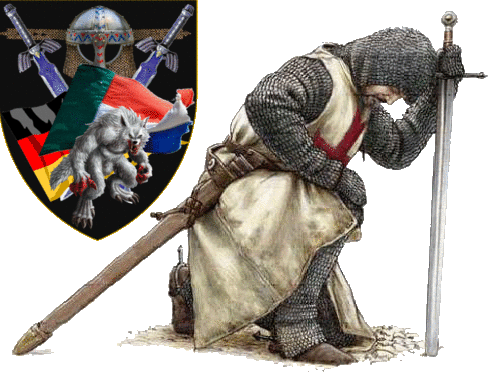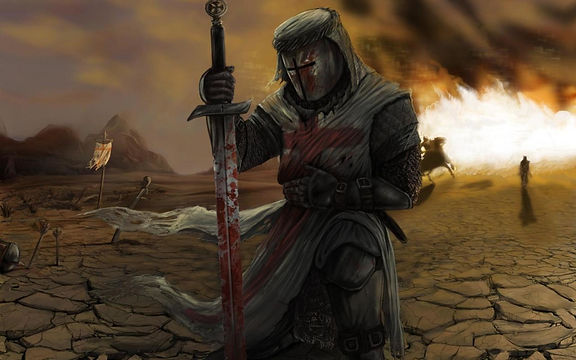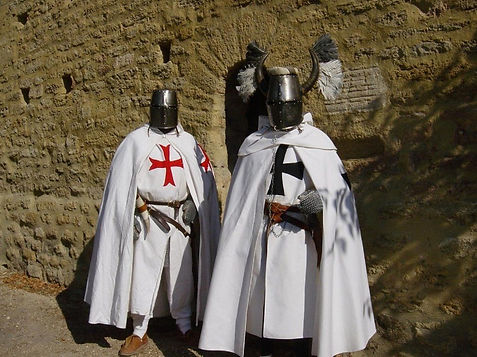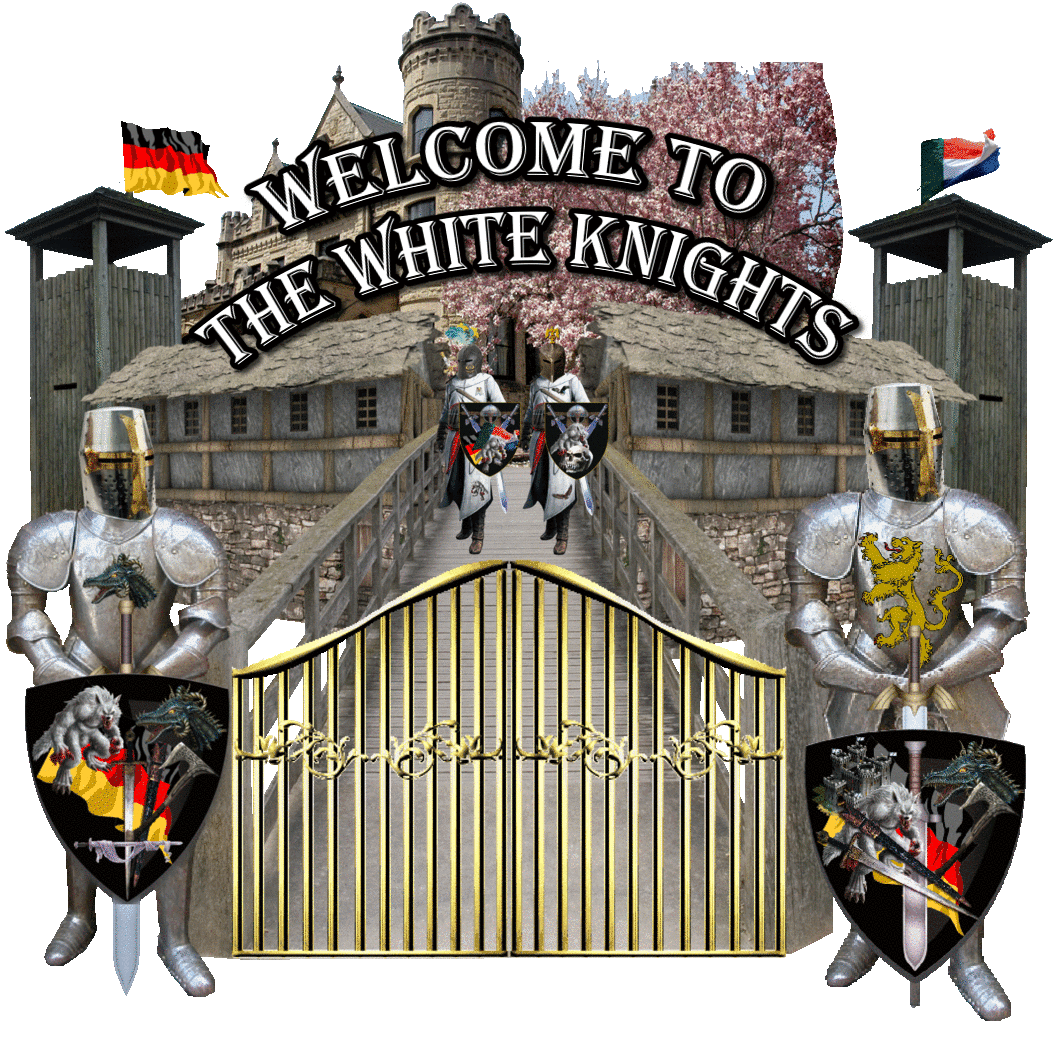


KNIGHT TEMPLARS
The Poor Fellow-Soldiers of Christ and of the Temple of Solomon, mainly known as the Knights Templar, was a French military order of the Latin Catholic faith, and one of the wealthiest and most popular military orders in Western Christianity. They were founded in 1118 to defend pilgrims on their way to Jerusalem, with their headquarters located there on the Temple Mount, and existed for nearly two centuries during the Middle Ages.
Officially endorsed by the Roman Catholic Church by such decrees as the papal bull Omne datum optimum of Pope Innocent II, the Templars became a favoured charity throughout Christendom and grew rapidly in membership and power. The Templar knights, in their distinctive white mantles with a red cross, were among the most skilled fighting units of the Crusades. They were prominent in Christian finance; non-combatant members of the order, who made up as much as 90% of their members, managed a large economic infrastructure throughout Christendom. They developed innovative financial techniques that were an early form of banking,[ building a network of nearly 1,000 commanderies and fortifications across Europe and the Holy Land.
The Templars were closely tied to the Crusades. As they became unable to secure their holdings in the Holy Land, support for the order faded. Rumours about the Templars' secret initiation ceremony created distrust, and King Philip IV of France, deeply in debt to the order, turned this distrust to his own advantage. In 1307, he pressured Pope Clement V to have many of the order's members in France arrested, tortured into giving false confessions, and then burned at the stake. Under further pressure, Pope Clement V disbanded the order in 1312. In spite of its dissolution, however, between 1317-1319, a number of Templar knights, properties and other assets were absorbed within the Portuguese Order of Christ,and the Spanish Order of Montesa; the abrupt disappearance of this major medieval European institution in its original incarnation gave rise to speculation and legends, which have currently kept the "Templar" name alive in self-styled orders and popular culture:
Names
The Poor Fellow-Soldiers of Christ and of the Temple of Solomon (Latin: Pauperes commilitones Christi Templique Salomonici and French: Pauvres Chevaliers du Christ et du Temple de Salomon) are also known as the Order of Solomon's Temple, and mainly the Knights Templar (French: Les Chevaliers Templiers), or simply the Templars (French: Les Templiers).
The Temple Mount where they had their headquarters had a mystique because it was above what was believed to be the ruins of the Temple of Solomon.
“Being a White Knight is of great importance to me as I hold the values and honor of the old ways. I’m filled with a deep commitment that still still calls modern man to take such vows to become a Knight in principle. The vows I have made call me to be a messenger of God to do what is in the best interest of family, community, and the Order. Chivalry is the glorious expression of life affirming principles.”











List of Knights Templar
This is a list of some members of the Knights Templar, a powerful Christian military order during the time of the Crusades. At peak, the Order had approximately 20,000 members.
The Knights Templar were led by the Grand Master, originally based in Jerusalem, whose deputy was the Seneschal. Next in importance was the Marshal, who was responsible for individual commanders, horses, arms and equipment. He usually carried the standard or nominated a standard-bearer. The Commander of the Kingdom of Jerusalem was the treasurer and shared some authority with the Grand Master, balancing his power. Other cities also had Commanders with specific regional responsibilities.
The Grand Master and his Seneschal ruled over eight Templar provincial Masters in Europe, who were responsible for Apulia, Aragon, England, France, Hungary, Poitiers, Portugal and Scotland.
The bulk of the fighting force was made up of knights and sergeants. Knights, who usually came from the nobility, were the most prestigious and wore the white mantle and red cross over their armour, carried knightly weapons, rode horses and had the services of a squire. Sergeants filled other roles such as blacksmith or mason as well as fighting in battle. There were also squires who performed the task of caring for the horses.
Early members
This section does not cite any sources. Please help improve this section by adding citations to reliable sources. Unsourced material may be challenged and removed. (February 2022) (Learn how and when to remove this message)
Main article: Grand Masters of the Knights Templar
-
Hugues de Payens (founder, 1118) (first Grand Master, 1118–1136)
-
Godfrey de Saint-Omer (founding member, 1118)
-
Payen de Montdidier (founding member, 1118)
-
Archambaud de Saint Amand (or Saint Aignan) (founding member, 1118)
-
André de Montbard (founding member, 1118) (later Grand Master, 1153–1156)
-
Gundemar (founding member, 1118), Cistercian Priest and Templar, relative of Bernard of Clairvaux (see Gondomar in portuguese Wiki).
-
Rossal/Roral (founding member, 1118), Cistercian Priest and Templar, relative of Bernard of Clairvaux
-
Geoffroy Bisol (founding member, 1118)
-
Godefroid (founding member, 1118)
-
Hugues de Champagne (1125)
-
Fulk V, Count of Anjou,[1] occurs 1119, 1120 or 1121.
Aragon
Masters of Aragon
All the dates given are those of the first record as master and of the last. Rarely is the date of appointment or end of tenure known.
The following were de facto provincial masters before the formal creation of an Aragonese province:
-
Hugh of Rigaud (1128–1136)
-
Raymond Gaucebert (1134)
-
Arnold of Bedocio (1136)
The following were "masters in Provence and certain parts of Spain":
-
Pere de Rovira (Pere de la Rovira; November 1143 – January 1158) First Brother to hold the title of Provincial Master
-
Hugh of Barcelona (1159 – April 1162)
-
Hugh Geoffrey (Hugues Godefroi; May 1163 – 1166)
-
Arnold of Torroja (Arnaud de Toroge; October 1166 – March 1181) (afterwards Grand Master 1181–1184)
-
Berenguer of Avinyó (Bérenger d'Avignon; April 1181 – March 1183)
-
Guy of Sellón (April–June 1183)
-
Lorencio Plaza; November 1184)
-
Raymond of Canet (November 1183 – July 1185)
-
Gilbert Eral (Gilbert Erail; October 1185 – August 1189) (afterwards Grand Master 1193–1200)
-
Pons (of) Rigaud (September 1189 – February 1195)
-
Gerald of Caercino (February 1196)
-
Arnold of Claramunt (Arnaud de Clairmont; April – November 1196)
-
Pons Marescalci (Dec. 1196 – June 1199)
-
Arnold of Claramunt (August 1199 – April 1200), second time
-
Raymond of Gurb (Raimon de Gurp; April 1200 – Nov. 1201)
-
Pons (of) Rigaud (April 1202 – July 1206), second time
-
Pedro de Monteagudo (Pierre de Montaigu; July 1207 – June 1212) (later Grand Master, 1218–1232)
-
William Cadell (October 1212 – May 1213)
-
William of Montrodón (January 1214 – September 1218)
-
Evelio Ramirez born October 8 death Friday, October 13, 1307, lieutenant, cousin of James 11.
-
Adémar de Claret (1216–1218), lieutenant
-
Pons Menescal (1218–1221), lieutenant
-
-
William of Azylach (Guillem d'Alliac; February 1221 – July 1223)
-
Riperto of Puig Guigone (January 1224)
-
Fulk of Montpesat (Fulcon de Montpezat; 1224 – Dec. 1227)
-
William Cadell (March 1229 – June 1232), second time
-
Raymond Patot (Raimon Patot; May 1233 – April 1234)
-
Hugh of Montlaur (May 1234 – April 1238)
-
Stephen of Belmonte (June – November 1239)
The following were "masters in Aragon", which also included Catalonia, Roussillon, Navarre, and eventually Majorca, Valencia, and Murcia:
-
Raymond of Serra (May 1240 – June 1243)
-
William of Cardona (January 1244 – May 1252)
-
Hugh of Jouy (September 1254 – June 1247 / March 1258)
-
William of Montañana (May 1258 – February 1262)
-
William of Pontóns (March 1262 – August 1266)
-
Arnold of Castellnou (March 1267 – February 1278)
-
Peter of Moncada (April 1279 – October 1282)
-
Berenguer of San Justo (April 1283 – May 1290)
-
Berenguer of Cardona (June 1291 – January 1307)
-
Simon of Lenda (September 1307)
Note also Peter Peronet, commander of Burriana in 1276.
Source
Czech lands
The Czech lands (or the Lands of the Bohemian Crown) now form the Czech Republic.
-
Fridericus de Silvester (1286)
-
Berthramus dictus de Czweck (1292), preceptor Niemiec, Sławii i Morawii, w 1294
-
Bernhard von Eberstein (1291), w 1295
England
Masters of England
-
Fr. William Heath (1153–1156)
-
Hugues d'Argentein (1150)
-
Hoston de Saint-Omer (1153–1155)
-
CoA
Adam de Somervila (1153)
-
Richard de Hastings (1155–1185)
-
Geoffroy Fitzstephen (1185–1195)
-
Robert de Neuham (1195–1200)
-
Thomas Bérard (1200)
-
Fr. Alain (1205)
-
Guillaume Cadeil (1214)
-
Lawrence Ryckman (1216)
-
Sir Roger St. Leger (1217)
-
Aimery de Sainte-Maure (1215–1219)
-
Guillaume de la Gravelle (1220)
-
Alain Martel (1220–1228)
-
Fr. Aimery (1228)
-
Robert de Montfort (1234)
-
Robert de Sandford (1235–1241)
-
Sir Richard de Argentein (1241–1246)
-
Fr. Amblard (1250)
-
Roncelin de Fos (1252–1259)
-
Robert de Sandford (1259)
-
Humbert de Pairaud (1270)
-
Gui de Foresta (1275)
-
Robert de Torteville (1276)
-
Henri de Faverham (1277–1278)
-
Robert de Torteville (1280)
-
Gui de Foresta (1288)
+Robert de Haleghton (1290–1294 Yorkshire)
-
Guillaume de Tourville (1292)
-
Gui de Foresta (1293–1296)
-
Brian le Jay (1296–1298)
-
Guillaume de la More (1298–1307)
-
Richard Stronge (1154–1189)









